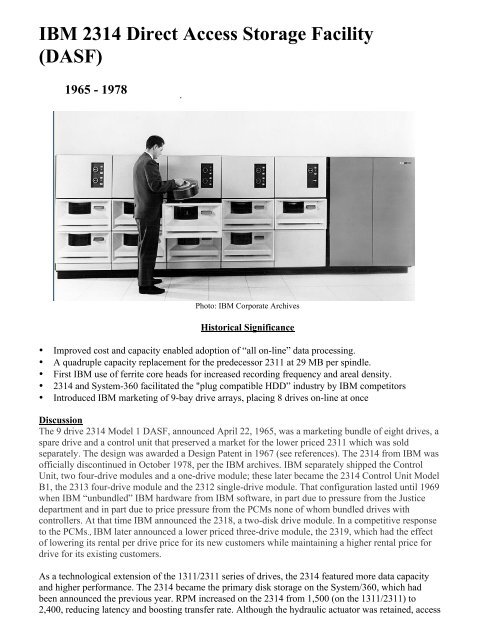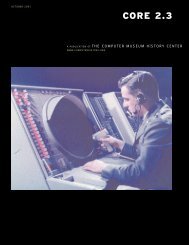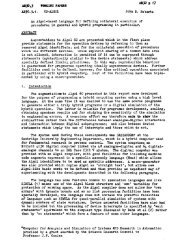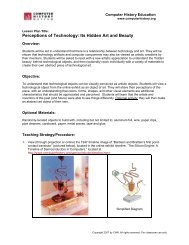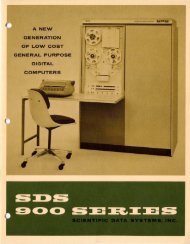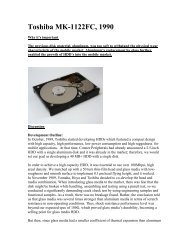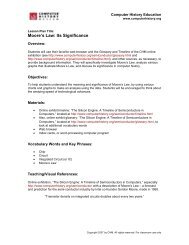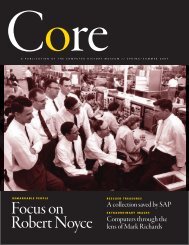IBM 2314 Direct Access Storage Facility - Computer History Museum
IBM 2314 Direct Access Storage Facility - Computer History Museum
IBM 2314 Direct Access Storage Facility - Computer History Museum
You also want an ePaper? Increase the reach of your titles
YUMPU automatically turns print PDFs into web optimized ePapers that Google loves.
<strong>IBM</strong> <strong>2314</strong> <strong>Direct</strong> <strong>Access</strong> <strong>Storage</strong> <strong>Facility</strong>(DASF)1965 - 1978.Photo: <strong>IBM</strong> Corporate ArchivesHistorical Significance• Improved cost and capacity enabled adoption of “all on-line” data processing.• A quadruple capacity replacement for the predecessor 2311 at 29 MB per spindle.• First <strong>IBM</strong> use of ferrite core heads for increased recording frequency and areal density.• <strong>2314</strong> and System-360 facilitated the "plug compatible HDD” industry by <strong>IBM</strong> competitors• Introduced <strong>IBM</strong> marketing of 9-bay drive arrays, placing 8 drives on-line at onceDiscussionThe 9 drive <strong>2314</strong> Model 1 DASF, announced April 22, 1965, was a marketing bundle of eight drives, aspare drive and a control unit that preserved a market for the lower priced 2311 which was soldseparately. The design was awarded a Design Patent in 1967 (see references). The <strong>2314</strong> from <strong>IBM</strong> wasofficially discontinued in October 1978, per the <strong>IBM</strong> archives. <strong>IBM</strong> separately shipped the ControlUnit, two four-drive modules and a one-drive module; these later became the <strong>2314</strong> Control Unit ModelB1, the 2313 four-drive module and the 2312 single-drive module. That configuration lasted until 1969when <strong>IBM</strong> “unbundled” <strong>IBM</strong> hardware from <strong>IBM</strong> software, in part due to pressure from the Justicedepartment and in part due to price pressure from the PCMs none of whom bundled drives withcontrollers. At that time <strong>IBM</strong> announced the 2318, a two-disk drive module. In a competitive responseto the PCMs., <strong>IBM</strong> later announced a lower priced three-drive module, the 2319, which had the effectof lowering its rental per drive price for its new customers while maintaining a higher rental price fordrive for its existing customers.As a technological extension of the 1311/2311 series of drives, the <strong>2314</strong> featured more data capacityand higher performance. The <strong>2314</strong> became the primary disk storage on the System/360, which hadbeen announced the previous year. RPM increased on the <strong>2314</strong> from 1,500 (on the 1311/2311) to2,400, reducing latency and boosting transfer rate. Although the hydraulic actuator was retained, access
time decreased from 85 to 60 milliseconds. Plug-compatible competitors often used somewhat differenttechnology, such as voice coil actuators but the same disk pack was common to all variants.The 29 MB type 2316 Disk Pack used with the <strong>2314</strong> employed 20 recording surfaces instead of 10found in the 1316 packs used with 1311/2311. The 2316 disk pack weighed about 10 pounds, large bytoday’s standards, but conveniently handled by most operators.<strong>IBM</strong> 2316 Disk PackPhoto from Roger Broughton <strong>Museum</strong>, UK – reference 4With 8 drives on-line, the system had about 240 MB available to the host, an impressive amount ofstorage for that time. The shipped sub-system weighed 4,290 pounds and consumed 9.1 kW of power.Any 8 of the 9 drives could be active at once, with drive selection involving a simple plastic “ID” plugfitting into a receptacle at the front of the drive.The <strong>2314</strong>’s success was due in part to the System/360, announced a year earlier. System/360standardized interconnections for system components, allowing <strong>IBM</strong> and competitors to “mix and match”their hardware. The very successful System/360 featured modularity of common and compatible devicesacross a large range of processors, creating a very large market for <strong>2314</strong> disk drives. Users could nowupgrade their system or add devices with relative ease. The resulting large market with standardization ofattachment was attractive to manufacturers of plug compatible alternatives (see: Memorex 660) whofound they could profitably sell a functionally equivalent or superior product at a lower price, eitherdisplacing installed <strong>IBM</strong> products or denying <strong>IBM</strong> the sale or lease of add-on system drives.The <strong>2314</strong> was offered on terms that made monthly rental financially more attractive than purchase; itspurchase price of $252,000 was 54 times the net monthly rental of $5,250 (including a $76.90 monthlymaintenance fee applicable to purchased drives) thus requiring 4.6 years to break even on a cash basis.Similarly, 2316 disk packs had a purchase price of $650 versus $20 per month rental. (see <strong>IBM</strong> pricingdata, appendix 1 and 2). Rental was extremely profitable for <strong>IBM</strong> since the products were expected tohave installed lives of five years or more (including re-marketing) but <strong>IBM</strong>’s initial costs wererecovered in far less time, perhaps less than a year. <strong>IBM</strong> pricing created both a large opportunity and asignificant problem for its competitors. The opportunity was to install “plug compatible” hardware onlarge numbers of <strong>IBM</strong> systems where existing <strong>IBM</strong> disk drives could be returned after a 30-day notice.The competitor’s problems included discounts from <strong>IBM</strong>’s pricing to attract customers, and the need tofund the hardware construction, sometimes requiring borrowed money which could take a long time torecoup the initial investment (plus interest) and show a profit. Additional risks included displacementby another competitor, obsolescence, the need to service the rental equipment, including sales cost tore-rent the returns. It’s somewhat ironic that small entrepreneurial companies such as Memorex orCalComp had to borrow money to provide rental equipment and service to wealthy customers such asBank of America, Pan AM, and Ford. Due to competition, <strong>IBM</strong> responded with price reductions andproduct reconfigurations, particularly the 2319, which reduced the profitability of its competitors and
caused some to leave the market. In some cases products were recycled which kept them in servicelonger than usual. One example is the Memorex 660, a plug compatible <strong>2314</strong> which came off lease inthe late 1970s and which was re-sold to DEC who then remarketed them as the RPR02.The <strong>2314</strong> was likely the first product with a capacity and price point to allow all of a user’s data toremain on line, replacing other storage systems in many applications. However, it should be noted thatsuch replacement was discussed as early as 1964 in the context of the 1311 and 1301 disk files. [Ref:Disk File Applications, American Data Processing, Inc., Detroit MI, (c) 1964]The <strong>2314</strong> introduced both ceramic flying heads and ceramic ferrite cores, replacing stainless steelheads and their Permalloy metallic cores. The ceramic flying head was mechanically more durable thanpreviously used stainless steel, and the ceramic ferrite core gave better high frequency performance.Metallic heads had their metallic cores mechanically "staked" in place, since metals are ductile andcould be "swaged" or locked in place. Ceramic components, being brittle, had to be adhesivelyattached. One disadvantage of the new epoxy bonded head technology was the ability of the core tomove slightly within the somewhat flexible plastic encapsulant ... it doesn’t take much position changeto effect magnetic performance of a pole tip at a nominal flying height of 85 micro-inches from thedisk surface. Alternative suppliers of similar heads in the merchant market (e.g. AMC, Infomag)encountered problems of pole tip recession or protrusion (related to the face of the flying head) whichdrove at least one supplier (Data Industries) out of business. This head design was often referred to asthe “Monkey Face” (see photo and patent reference), with two holes to bleed air from between the diskand head, improving lateral stability. The coil spring between the plug and arm surrounded the leads tothe head and served as a radio frequency shield. Subsequent technology improvements used glassbonding (first used by <strong>IBM</strong> on 3330) to eliminate the pole tip movement issue.In practice, the heads and disk surfaces were routinely cleaned by field engineers using isopropylalcohol on a soft cloth held by a tool resembling a “popsicle stick”. Signs of trouble would includereddish iron oxide deposits removed from heads and/or disks indicating mechanical interferencebetween the two. If not corrected promptly, this contamination could spread by moving the disk packfrom drive to drive. Unfortunately some users experiencing data recovery problems would make theproblem worse by mounting the damaged disk pack on multiple drives, contaminating them all, whichbecame referred to as the “Typhoid Mary” syndrome.<strong>IBM</strong> <strong>2314</strong> Read/Write Head showing “monkey face” head design (right)Photos from Roger Broughton <strong>Museum</strong>, UK – reference 4The recording principle is equivalent to tape drives of the era, using a magnetic core to both write andread data on the surface. The recordings are surprisingly robust, with data on an original 1950s eraRAMAC storage system (currently on display at the <strong>Computer</strong> <strong>History</strong> <strong>Museum</strong>) still readable, Thedisk pack used magnetic iron oxide in an epoxy-phenolic cross-linked binder, applied by spin-coating awet slurry onto a slowly spinning aluminum substrate (see patent reference 3,198,657). The disk withits “magnetically painted” surface, was subsequently oven-baked and polished to a smooth surface.
The disk pack was assembled on an aluminum alloy hub, with ventilated spacers between the disks tofacilitate air flow into the head-media interface. Air entering the disk pack area was filtered by anautomotive-style porous paper filter, to prevent room dust being caught between heads and media.Airborne particles could easily exceed the 85 micro-inch head-to-disk spacing, so had to be controlled.A high-end automotive air filter is quoted at “100% efficient at 3 microns” (or 118 micro-inches),which takes care of most dirt, allowing disk drives to survive in unclean environments—historicalanecdotes describe disk packs routinely being used in coal mines and dusty factories. Filtration at <strong>IBM</strong>was evaluated and tested with various contaminants during <strong>2314</strong> development, and the <strong>2314</strong> disk drivefiltering system was subsequently improved with the <strong>IBM</strong> 3330 to a HEPA (High EfficiencyParticulate Arresting) filter for elimination of aerosols/smoke down to 0.3 micrometer (about 12 microinches).Some <strong>2314</strong> competitors (e.g. Memorex) adopted HEPA filters for their <strong>2314</strong>-compatibledrives, providing a reliability advantage. More detail on this issue is provided in the 1311/2311 article,during which product life the engineering work on aerosols and corrective action leading to HEPAfiltration was done.Both photos from Roger Broughton <strong>Museum</strong>, UK – reference 4+The <strong>2314</strong> also inaugurated <strong>IBM</strong>’s use of self-clocking FM (2-frequency, or "double frequency")encoding, which was more reliable since timing came from the data on the disk itself (see Patentreference 3,356,934). In this concept, a single frequency is always recorded as the reference signal forthe decoder, and data bits are placed between the clock bits. Good news was greater reliability, badnews was 1/2 of the recorded data was consumed for machine timing and thus was unavailable for userdata. Subsequent recording schemes, such as MFM and RLL, improved the ratio of user data toclocking data.A summary of <strong>2314</strong> features:Highlights:• First use of ferrite (non-metallic) read/write transducer in a disk drive• First use of non-metallic (alumina ceramic) flying head or “slider”• First application of 9 disk drive array (8 active + 1 spare) in one array• 29 MB per spindle, versus 2.0 MB for 1311 or 7.25 MB for 2311
Shortcomings:• Increased sensitivity to airborne contamination due to lower flying height• Greater sensitivity to pole tip recession and protrusion• Cross-contamination from disk pack swapping, ”Typhoid Mary” syndrome• 20 surfaces to vertically align, greater sensitivity to spindle tilt• Mechanical hydraulic actuator, final use in an <strong>IBM</strong> disk driveAdditional information<strong>IBM</strong> San Jose, A Quarter Century Of Innovation”, David W. Kean, 1977, CHM accession number:102687875See also the <strong>IBM</strong> <strong>2314</strong> website and these website locations1. http://www.computerhistory.org/revolution/memory-storage/8/259/10462. http://www-03.ibm.com/ibm/history/exhibits/storage/storage_<strong>2314</strong>.html3. http://www.beagleears.com/lars/engineer/comphist/ibm360.htm4, http://www.staff.ncl.ac.uk/roger.broughton/museum/DASD/200426.htm5. http://en.wikipedia.org/wiki/<strong>IBM</strong>_System/3606. http://bitsavers.org/pdf/ibm/28xx/2844/GA26-3599-6_<strong>2314</strong>_2844_Component_Description_Nov71.pdfRelevant <strong>IBM</strong> PatentsUS 3,198,657 “Process for spin coating objects”, Philip Kimball, 17 Sep 1964Des. 208,308 “Data <strong>Storage</strong> Unit” (<strong>2314</strong> array) Donald Wood & Dave Brodsky, 15 Aug 1967US 3,631,425 “Magnetic Slider with Orifice”, Tom Tang, 28dec 1971Moderator: Bill Carlson
Appendix 1 – <strong>IBM</strong> <strong>2314</strong> announcement, features & benefits
Appendix 2 – <strong>IBM</strong> <strong>2314</strong> Price & delivery schedule


